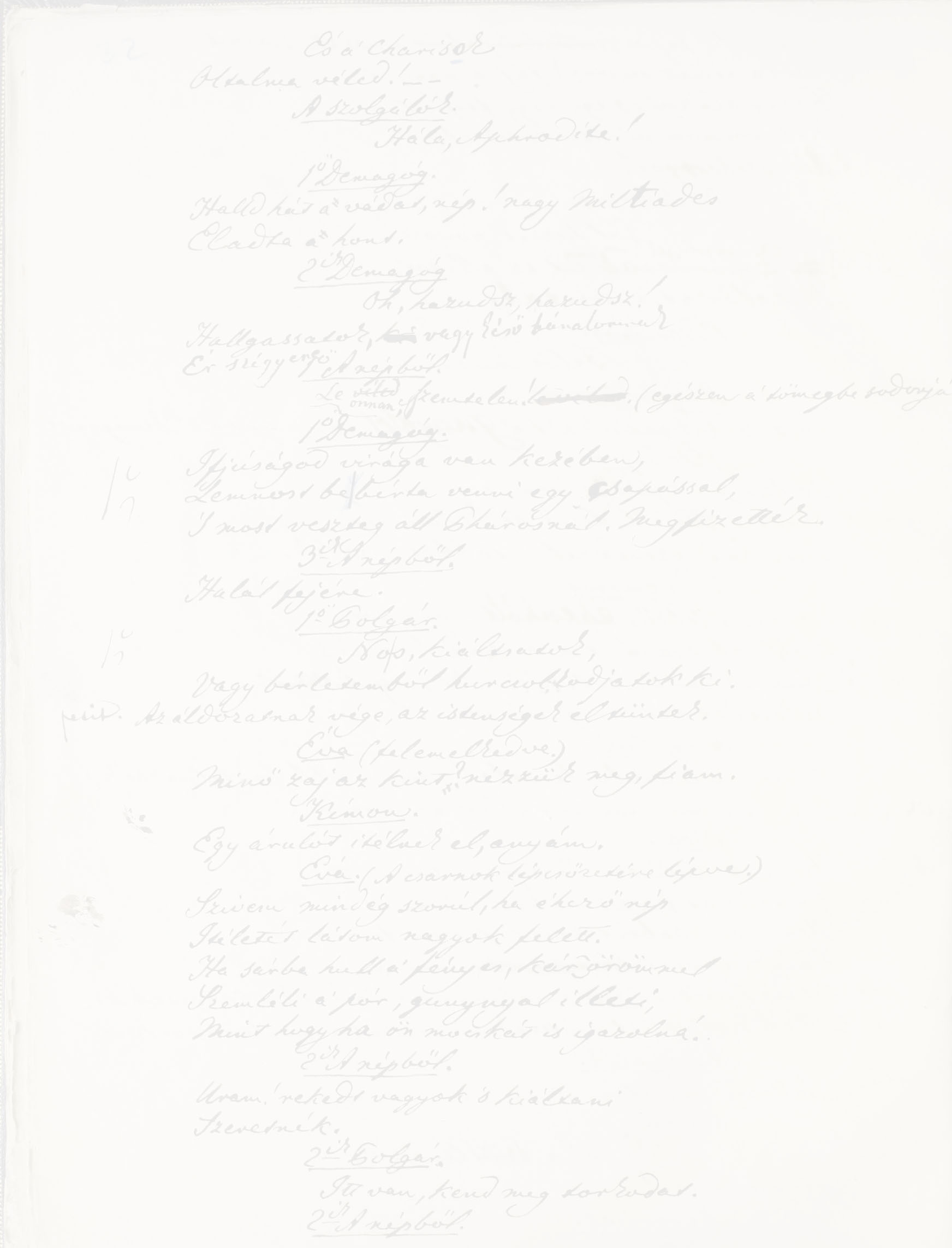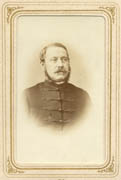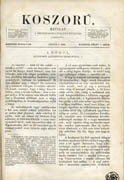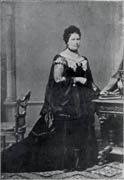


After the defeat of the War of Independence, in August 1849 the
operation of the Hungarian Academy of Sciences was banned by the imperial
government. Fron then on for nearly a decade the scholarly institution could
only exert a limited activity. They could not have public events or general
meeting, and consequently could elect no new members. A condition to start full
operation again was to adopt a new statute, in which they recognize the
authority of the ruler and the control of the authoritarian government. (The
Hungarian Academy of Sciences was founded as a national collaboration, on the
initiative of István Széchenyi, in this respect it was an exception among the
great academic institutions of the period, usually founded by rulers.)
In
1858 the new statue was forced on the Academy, thus it could start its full
operation with a general assembly and with the election of almost a hundred new
members.
The following years were those of peaceful scholarly work. In 1863, the year of
the election of Imre Madách a member of the Academy, the historian László Szalay,
general secretary of the Academy could proudly enumerate the scholarly results
of the past year, the volumes published with the collaboration of the five
permanent academic committees, the scientific results, the Corvinas discovered
in Istanbul, the Central Asian research of Ármin Vámbéry
1
The then existing statute did not require the preparation of the member
recommendation in the modern sense, that is, a detailed explanation of the
candidate’s biography and scientific results. In contemporary usage, one or more
voting members of the Academy presented a name or even a list to the respective
scientific class; at the meeting of the class it was discussed, and they
submitted the approved names to the electing general assembly. The HAS had six
classes at the time, Class I (Language and Fine Sciences) also included writers
and other artists. According to §. 29 of the statutes, the scientific classes
could recommend such scholars and authors for corresponding members who have
already proved with their oeuvre that they are suitable to realize the goals of
the Academy.
2
 In 1863, the Language and Fine Arts Departments presented their recommendations
in one sheet. The submission was drafted by Zsigmond Kemény, a honorary member
of the Academy, and it was also signed by Ferenc Toldi, Pál Hunfalvy, Gábor
Fábián, János Arany, János Nagy and Mór Ballagi.
3
In 1863, the Language and Fine Arts Departments presented their recommendations
in one sheet. The submission was drafted by Zsigmond Kemény, a honorary member
of the Academy, and it was also signed by Ferenc Toldi, Pál Hunfalvy, Gábor
Fábián, János Arany, János Nagy and Mór Ballagi.
3
 They recommended in the first place the composer Count Leó Festetics, and in the
second Imre Madách, member of the Kisfaludy Society, the eminent author of
The tragedy of man. The six candidates also include Ferenc Erkel, “due to
his great merits concerning national opera”. He was nominated several times, but
never elected among the members of the HAS.
They recommended in the first place the composer Count Leó Festetics, and in the
second Imre Madách, member of the Kisfaludy Society, the eminent author of
The tragedy of man. The six candidates also include Ferenc Erkel, “due to
his great merits concerning national opera”. He was nominated several times, but
never elected among the members of the HAS.
In January
1863 they held the 24th general assembly of the HAS, and on the 12 January
meeting they elected the members. The ordinary and honorary members (at that
time the corresponding members had no right to vote), thirty-seven in all,
secretly cast their votes. According to the protocols, Imre Madách was elected
in the first place, with 32 votes and 3 against, a corresponding member of the
Academy in the Class of Language and Fine Arts. Apart from him, Miklós Szemere
and József Lévay received enough votes.
4
In the 18 April 1864 meeting of the Class of Language and Fine
Arts, corresponding member Károly Bérczy read the inaugural dissertation of the
ill Imre Madách, with the title On the woman, especially in aesthetic respect.
5
The meeting was presided by Emil Dessewffy, president of the HAS, and the
members appeared in a rather large number, more than thirty.
6
The at first sight surprising title introduces a dissertation, in which Imre
Madách discusses the different roles of men and women, and – in Madách’s words –
explores the disadvantages of when the woman quits her traditional social and
gender role. According to Madách, the physical difference between the two
genders also appears in the intellectual field. The guiding principle of his
inaugural speech is often quoted as a commonplace: “The woman evolves earlier,
but never arrives at a complete male maturity; she understands and learns
easier, but in lack of a creative genius she can never rise among the guiding
spirits of mankind.” This nowadays astounding claim was generally accepted
in the period. Madách, who was interested and knowledgeable in natural sciences,
certainly read the study of Pál Almási Balogh – honorary member of the HAS, a
famous physician of his age, who treated Lajos Kossuth and accompanied Széchenyi
to Döbling as the doctor of the family –,
7
and in some places his impact can be detected in his essay. In his study,
published in several parts, the prominent physician claimed on the basis of
natural scientific arguments that women, due to their biological and physical
features, lack the conditions of attain deeper thinking and rising into higher
spheres of intellectual world.

Szándéka szerint a székfoglaló nem a nők alacsonyabb rendűségét kivánja
bizonyítani. Amint a természet is sokszínű, a férfi és nő között sincs merev
válaszfal – írja Madách. Születhetnek olyan nők, akik magas szellemiségükkel
felülemelkednek nemük korlátain, s egyenrangúvá válnak a férfiakkal – s tegyék
is azt, mondja Madách –, de ezzel lemondanak nemük mindazon előnyeiről, amik
nőként ragyogóvá és boldoggá teszik őket.
Madách szerint a férfi és a nő közötti különbség figyelembe nem vétele, azaz, ha
valaki a női emancipációt hirdeti, nagyon tévesen cselekszik, s aligha tesz jó
szolgálatot azoknak, akiknek kedvezni akar.
Legyen a nő egyenlő a férfival jogban, tiszteletben pedig álljon felette. De ne
éljen a nő jogaival végletekig (azaz ne lépjen ki a hagyományos női szerepből),
s gesztusának kedves viszonzása lesz azon hódolat, mellyel a férfi maga fölé
emeli – fejezi be gondolatmenetét az író.
 Madách meglehetősen hosszú dolgozata 1864 nyarán jelent meg három folytatásban
Arany János hetilapjában, a Koszorúban. Nyilvános vitát nem keltett, de Veres
Pálné, Madách Imre régi ismerőse, plátói szerelme és
szellemi partnere 1864 kora őszén két levelet is intézett az íróhoz, tiltakozva
sommás megállapításai ellen. Ezek a levelek vagy
levélfogalmazványok – nem tudjuk, hogy eljutottak-e Madách Imréhez – eltűntek az
idők folyamán, csak Veres Pálné életrajzi kötetéből ismerjük tartalmukat.
8
Veres
Pálnét elsősorban az a megállapítás döbbentette meg, hogy a nő soha sem
emelkedhet a férfi szellemi színvonalára. Az egyik levélben a nők helyzetét az
észak-amerikai fekete rabszolgákéhoz hasonlította (ekkor zajlott az amerikai
polgárháború), s kijelentette, hogy a rabszolgatartáshoz hasonlatos azon
gondolkodásmód, amelyik a női nemet kizárólag a mechanikus tevékenységre
szorítaná. Szenvedélyesen cáfolja, hogy a nőt a természet kevesebb szellemi
tehetséggel ruházta volna
föl. Úgy gondolja, gyakorlat teszi a mestert, aki tanul, gondolkodik,
kísérletez, fejleszti magát a tudományokban, szép eredményre juthat, legyen az
férfi vagy nő.
Madách meglehetősen hosszú dolgozata 1864 nyarán jelent meg három folytatásban
Arany János hetilapjában, a Koszorúban. Nyilvános vitát nem keltett, de Veres
Pálné, Madách Imre régi ismerőse, plátói szerelme és
szellemi partnere 1864 kora őszén két levelet is intézett az íróhoz, tiltakozva
sommás megállapításai ellen. Ezek a levelek vagy
levélfogalmazványok – nem tudjuk, hogy eljutottak-e Madách Imréhez – eltűntek az
idők folyamán, csak Veres Pálné életrajzi kötetéből ismerjük tartalmukat.
8
Veres
Pálnét elsősorban az a megállapítás döbbentette meg, hogy a nő soha sem
emelkedhet a férfi szellemi színvonalára. Az egyik levélben a nők helyzetét az
észak-amerikai fekete rabszolgákéhoz hasonlította (ekkor zajlott az amerikai
polgárháború), s kijelentette, hogy a rabszolgatartáshoz hasonlatos azon
gondolkodásmód, amelyik a női nemet kizárólag a mechanikus tevékenységre
szorítaná. Szenvedélyesen cáfolja, hogy a nőt a természet kevesebb szellemi
tehetséggel ruházta volna
föl. Úgy gondolja, gyakorlat teszi a mestert, aki tanul, gondolkodik,
kísérletez, fejleszti magát a tudományokban, szép eredményre juthat, legyen az
férfi vagy nő.